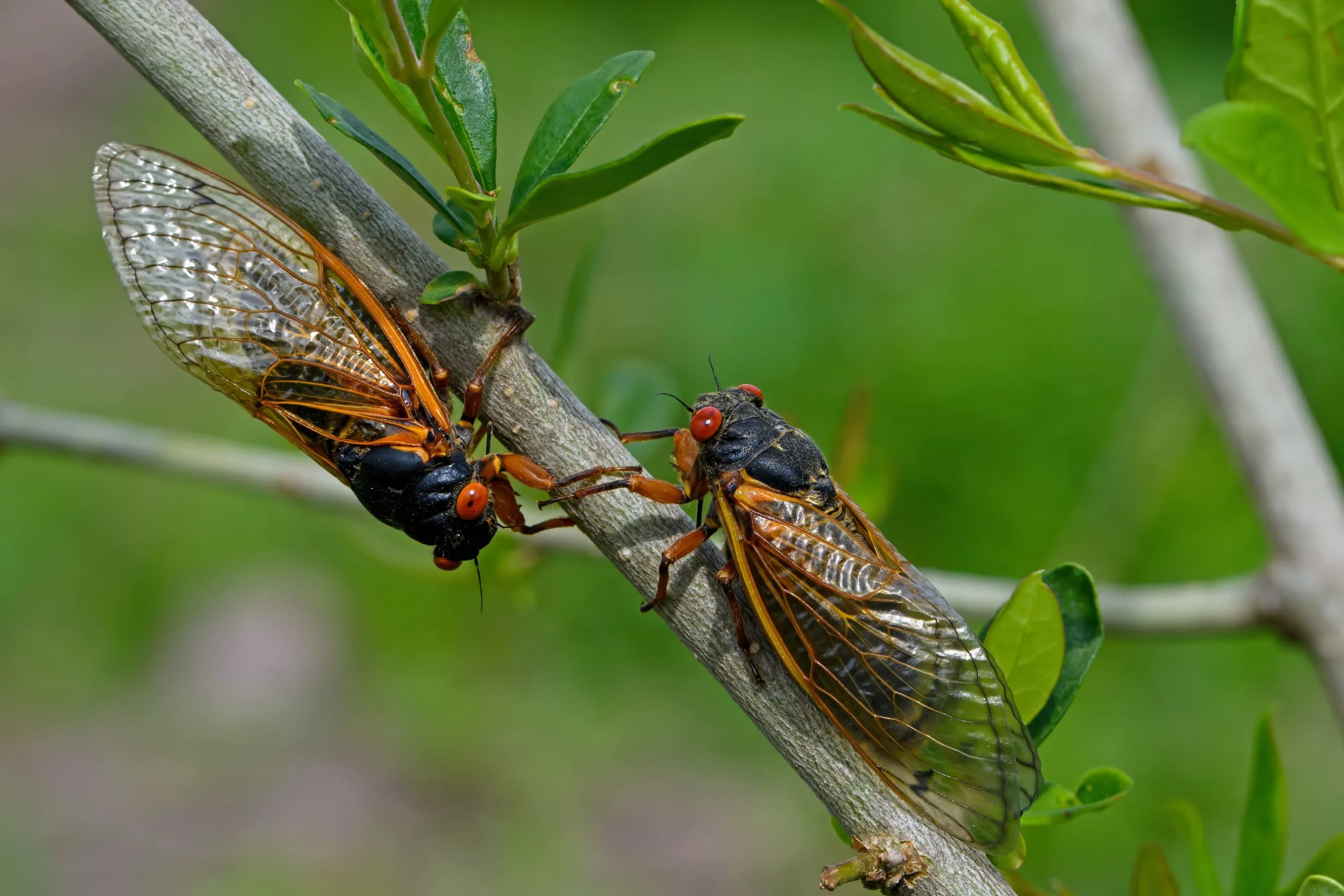
Cicadas belong to the superfamily Cicadoidea within the insect order Hemiptera. They are part of the suborder Auchenorrhyncha, which also includes other small jumping insects like leafhoppers and froghoppers.
Cicadas, with their distinctive buzzing sound created by specialized organs called tymbals on their abdomen, are fascinating insects that captivate both scientists and nature enthusiasts. This unique feature sets them apart from other insects and contributes to their characteristic chorus heard in many regions. The rhythmic buzzing serves as a mating call, allowing males to attract females for reproduction. This natural symphony of cicadas is a testament to their remarkable adaptation and communication skills in the wild.
With over 3,000 known species worldwide, cicadas showcase an incredible diversity within the insect world. Each species exhibits specific behaviors, physical characteristics, and habitats, contributing to the rich tapestry of insect life on Earth. Scientists continue to discover new species and study existing ones to unravel the complexities of cicada biology and ecology. The sheer number of cicada species highlights their importance in various ecosystems and their role in maintaining biodiversity.
Periodical cicadas, known for their unique 13- or 17-year life cycles, present a biological mystery that has intrigued researchers for centuries. The synchronization of these emergence patterns remains a subject of scientific inquiry, with theories ranging from predator avoidance to genetic triggers. The precise timing of these cycles adds to the mystique surrounding periodical cicadas and underscores the intricate mechanisms at play in the natural world. Studying these phenomena provides valuable insights into evolutionary strategies and population dynamics among cicada species.
The Megapomponia imperatoria, the largest species of cicada with wingspans reaching up to 8 inches, commands attention with its impressive size and appearance. This giant among cicadas showcases the incredible diversity of forms within the insect kingdom, challenging perceptions of insect size and structure. The Megapomponia imperatoria’s imposing wingspan allows it to navigate through its habitat with grace and efficiency, highlighting the remarkable adaptations that have evolved in cicadas over millions of years.
Fossils of cicadas dating back to the time of the dinosaurs provide a glimpse into the ancient origins of these remarkable insects. Their presence in prehistoric ecosystems underscores their resilience and adaptability as a group. Studying cicada fossils offers valuable insights into their evolutionary history and ecological interactions throughout geological time. The longevity of cicadas on Earth reflects their successful survival strategies and their enduring impact on terrestrial ecosystems.
The Brevisana brevis, the loudest cicada species capable of producing sounds up to 120 decibels, stands out as an auditory powerhouse in the insect world. This remarkable ability to generate intense sounds serves vital functions in communication, mate attraction, and territorial defense. The Brevisana brevis’s loud calls reverberate through its environment, signaling its presence and dominance to potential mates and rivals. The evolution of such high-decibel sound production in cicadas showcases the ingenuity and complexity of insect acoustic communication systems.
Female cicadas utilize their ovipositors, specialized egg-laying organs, to deposit eggs in tree branches, a crucial step in their reproductive cycle. This intricate process involves precise placement of eggs to ensure the survival of offspring and the continuation of the species. The oviposition behavior of female cicadas reflects their adaptation to specific habitats and resources, highlighting the interconnectedness between cicadas and their environment. By carefully selecting suitable sites for egg deposition, female cicadas contribute to the success of future generations and the persistence of cicada populations.
Cicadas, as a food source for various predators including birds, small mammals, and even humans in certain cultures, play a vital role in food webs and nutrient cycling within ecosystems. Their abundance and nutritional value make them an attractive prey item for many animals, contributing to the ecological balance in their habitats. The consumption of cicadas by different organisms reflects the interconnectedness of species in natural communities and the cascading effects of their presence or absence. Understanding the role of cicadas in food chains sheds light on the complexity of ecosystem dynamics and the importance of preserving biodiversity.
The life cycle of cicadas, which can range from 2 to 17 years depending on the species, unfolds in a series of developmental stages marked by molting and metamorphosis. This prolonged life cycle allows cicadas to adapt to specific environmental conditions and optimize their reproductive success. The variation in life cycle lengths among cicada species reflects their evolutionary strategies for survival and persistence in diverse habitats. By undergoing multiple molting stages and transformations, cicadas demonstrate resilience and flexibility in the face of changing environmental pressures, showcasing the remarkable adaptability of these insects.
Cicadas possess piercing-sucking mouthparts that enable them to feed on tree sap, a vital energy source for their growth and development. This specialized feeding adaptation allows cicadas to extract nutrients from plant tissues while minimizing damage to their host plants. By tapping into the sap flow of trees, cicadas obtain essential nutrients such as sugars and amino acids necessary for their survival. The efficiency of their feeding mechanism reflects the coevolutionary relationship
The Pilaspis mariae, the smallest species of cicada measuring only about 13mm in length, showcases the diversity of sizes within the cicada family. Despite its diminutive stature, the Pilaspis mariae plays a significant role in its ecosystem, contributing to nutrient cycling and food webs in its habitat. Its small size may offer advantages in terms of predator evasion and resource utilization, highlighting the adaptations that enable cicadas to thrive in various environments.
Cicadas, known for their harmless nature towards humans and pets as they do not sting or bite, embody a peaceful coexistence with other creatures in their surroundings. This lack of defensive mechanisms underscores their reliance on camouflage, warning coloration, or behavioral strategies to deter potential threats. By avoiding direct confrontation with larger animals, cicadas demonstrate a survival strategy based on concealment and vigilance, allowing them to navigate their environment safely.
Some species of cicadas have been known to cause damage to fruit trees due to their feeding habits, highlighting the ecological impact of these insects on agricultural systems. The piercing-sucking mouthparts of cicadas can disrupt the flow of nutrients in plant tissues, leading to wilting, stunted growth, or deformities in fruit crops. Farmers and gardeners may implement control measures to manage cicada populations and protect their crops from potential damage, balancing the need for pest control with the preservation of natural ecosystems.
Cicadas undergo incomplete metamorphosis, a developmental process characterized by nymphal stages and gradual maturation into adults. This mode of development involves multiple molting events during which cicadas shed their exoskeletons to accommodate growth and physiological changes. The transition from nymph to adult represents a critical phase in the life cycle of cicadas, marking the culmination of their development and readiness for reproduction. The incomplete metamorphosis of cicadas exemplifies the diversity of insect life cycles and the intricate adaptations that facilitate their survival in dynamic environments.
The transparent and veined wings of cicadas enable them to fly with efficiency and agility, essential for foraging, mate seeking, and predator evasion. These delicate structures provide lift, stability, and maneuverability during flight, allowing cicadas to navigate diverse habitats and exploit available resources. The intricate wing venation of cicadas reflects adaptations for aerodynamic performance and energy conservation, optimizing their flight capabilities for various ecological tasks. The evolution of specialized wing morphology in cicadas highlights the selective pressures driving insect diversification and success in aerial environments.
Cicadas are known for their synchronized mass emergences, where thousands of individuals appear simultaneously to mate, reproduce, and complete their life cycles. This phenomenon, observed in many cicada species, represents a strategy for maximizing reproductive success and population persistence. The coordinated emergence of cicadas enhances mate finding, reduces individual predation risk, and increases genetic diversity within populations. By synchronizing their life cycles, cicadas demonstrate a collective approach to survival and reproduction, emphasizing the benefits of cooperation and timing in natural systems.
The Magicicada septendecim, the longest-lived cicada species capable of living up to 17 years underground, exemplifies the endurance and patience of these remarkable insects. This extended period of subterranean existence allows cicadas to avoid predators, conserve energy, and synchronize their emergence with favorable environmental conditions. The longevity of the Magicicada septendecim underscores the evolutionary advantages of prolonged life cycles in certain cicada species, balancing reproductive investment with survival strategies in dynamic ecosystems.
Cicadas are primarily diurnal insects, active during the day when temperatures are conducive to their physiological functions and behavioral activities. Males produce their loud calls to attract females and establish territories, engaging in acoustic signaling to communicate their presence and reproductive fitness. The daytime activity patterns of cicadas reflect adaptations to diurnal ecological niches, optimizing their foraging, mating, and predator evasion strategies. By aligning their behaviors with daylight hours, cicadas demonstrate a synchronization with environmental cues and biological rhythms that shape their daily routines.
In some cultures, cicadas are revered as symbols of rebirth, immortality, and good luck, embodying spiritual significance and cultural symbolism. These insects hold special meanings in folklore, mythology, and art, representing themes of transformation, renewal, and resilience. The symbolic value of cicadas transcends their biological attributes, resonating with human emotions, beliefs, and aspirations across diverse societies. By associating cicadas with positive qualities and auspicious omens, cultures worldwide celebrate the enduring legacy of these enigmatic insects in the human imagination.
Cicadas are classified under the order Hemiptera and the family Cicadidae, placing them within a taxonomic framework that reflects their evolutionary relationships and biological characteristics. This systematic classification highlights the shared traits and evolutionary history of cicadas with other insects in the same taxonomic groups. By categorizing cicadas based on morphological, genetic, and ecological criteria, scientists can elucidate their phylogenetic
The large and prominent eyes of cicadas provide them with a wide field of vision, essential for detecting predators, locating mates, and navigating their environment. These well-developed compound eyes offer cicadas visual acuity and sensitivity to light variations, enabling them to perceive their surroundings with clarity and precision. The visual adaptations of cicadas reflect their reliance on sight for essential behaviors such as foraging, communication, and predator avoidance, underscoring the importance of vision in their survival strategies.
Cicadas are renowned for their distinctive mating calls, characterized by loud buzzing or clicking sounds produced by males to attract females for reproduction. These acoustic signals serve as courtship displays, territorial markers, and mate recognition cues, facilitating communication among cicadas over long distances. The evolution of complex mating calls in cicadas reflects the interplay of genetic, behavioral, and environmental factors shaping their reproductive strategies. By fine-tuning their acoustic signals, cicadas optimize their chances of successful mating and reproductive success in competitive environments.
Cicadas are vital contributors to ecosystem health, playing key roles in soil aeration and tree maintenance through their feeding and oviposition behaviors. By puncturing tree branches to lay eggs and feeding on xylem sap, cicadas promote nutrient cycling, wound healing, and branch pruning in forest ecosystems. Their activities influence tree growth, nutrient dynamics, and microbial communities, demonstrating the interconnectedness between cicadas and their habitat. The ecological services provided by cicadas underscore their significance as ecosystem engineers and keystone species in forested landscapes.
Cicadas have inspired artists, writers, and musicians throughout history, serving as symbols of metamorphosis, renewal, and natural beauty in various cultural expressions. From ancient myths and folklore to contemporary literature and visual arts, cicadas have captivated human imagination with their mysterious allure and symbolic resonance. Their presence in creative works reflects themes of transformation, resilience, and the cyclical nature of life, inviting contemplation on the interconnectedness of all living beings and the rhythms of the natural world. Through artistic interpretations, cicadas continue to inspire awe and wonder in audiences worldwide.
The study of cicadas, known as cicadology, encompasses a diverse range of scientific disciplines including entomology, ecology, behavior, and evolution. Researchers investigate various aspects of cicada biology, from their life cycles and communication systems to their ecological interactions and evolutionary history. The field of cicadology continues to yield new discoveries, insights, and conservation implications for these enigmatic insects, shedding light on their ecological roles and conservation status. By advancing our understanding of cicadas through interdisciplinary research, cicadologists contribute to broader knowledge of insect diversity, ecosystem dynamics, and environmental stewardship.
Cicada FAQs: Unveiling the Mystery of the Brood
Cicadas, those mysterious buzzing insects that emerge seemingly out of nowhere, have captivated humans for centuries. Here are some FAQs to shed light on their fascinating life cycle and behavior:
1. What are cicadas?
Cicadas are large, plant-eating insects with distinctive clear or black wings and bulging red eyes. They are known for their loud, buzzing songs produced by males to attract mates.
2. What’s the deal with the long life cycle?
Unlike most insects with short lifespans, cicadas have a unique life cycle that can span years, most commonly 13 or 17 years. This extended period is spent underground as nymphs, feeding on tree root fluids.
3. Why do they emerge in large numbers?
Cicadas employ a strategy called “predator satiation.” By emerging in massive broods (groups hatched in the same year), they overwhelm potential predators like birds, increasing the chances of individual cicadas surviving long enough to reproduce.
4. What happens when they finally emerge?
Once triggered by environmental cues like soil temperature, cicadas burrow out of the ground as nymphs. They then molt, shedding their exoskeleton and emerging as winged adults.
5. What’s the purpose of the loud buzzing?
The loud, pulsating songs produced by male cicadas are for attracting mates. These songs can reach over 100 decibels, making them one of the loudest insect noises in the world.
6. Do cicadas bite or sting?
No, cicadas do not have stingers or any biting mouthparts. Their mouthparts are adapted for sucking fluids from plant roots.
7. What do cicadas eat?
As adults, cicadas feed on sap from tree stems and twigs using a straw-like proboscis. This doesn’t harm the trees in most cases.
8. How long do adult cicadas live above ground?
Adult cicadas only live for a few short weeks after emerging. Their primary purpose during this time is to mate and lay eggs before dying.
9. Are cicadas harmful?
Cicadas pose no real threat to humans or pets. However, their sheer numbers can be overwhelming, and their fallen exoskeletons can create a slippery mess on sidewalks. Additionally, some people might find their loud buzzing bothersome.
10. What are the different types of cicadas?
There are over 3,000 cicada species worldwide. In North America, the most famous are periodical cicadas with 13- or 17-year lifecycles. However, there are also annual cicadas that emerge every year.
11. When can we expect to see the next big cicada emergence?
Due to the staggered lifecycles of different broods, there’s usually a cicada emergence event happening somewhere in North America every few years. However, specific emergence times depend on the brood and location.
12. What are some interesting facts about cicadas?
- Cicadas are ancient insects with fossils dating back millions of years.
- Some cicada species have synchronized emergences, with entire forests erupting in song simultaneously.
- Cicadas are a vital food source for many animals during emergence periods.
- Native American cultures have incorporated cicadas into their folklore and mythology.
By understanding the life cycle and behavior of cicadas, we can appreciate these remarkable insects and their unique role in the ecosystem.









